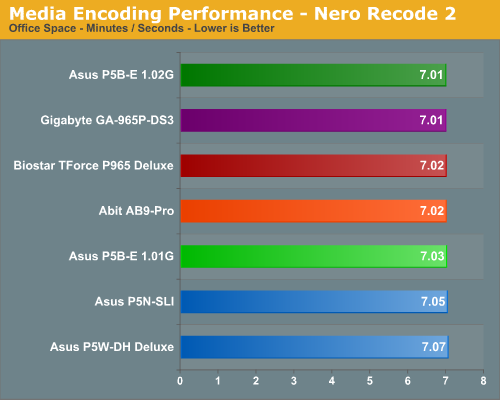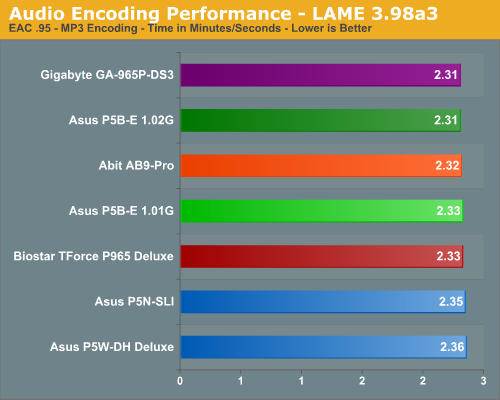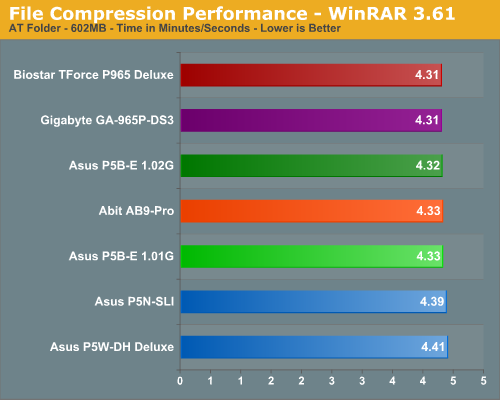Intel P965: Mid-Range Performance Sector Roundup
by Gary Key on October 20, 2006 9:00 PM EST- Posted in
- Motherboards
Media Encoding Performance
Our first test is quite easy - we take our original Office Space DVD and use AnyDVD Ripper to copy the full DVD to the hard drive without compression, thus providing an almost exact duplicate of the DVD. We then fired up Nero Recode 2, selected our Office Space copy on the hard drive, and performed a shrink operation to allow the entire movie along with extras to fit on a single 4.5GB DVD disc. We left all options on their defaults except we checked off the advanced analysis option. The scores reported include the full encoding process and are represented in minutes and seconds, with lower numbers providing better performance.

The results were interesting as the P965 boards scored better than the 975X board. We have seen this in previous testing with this benchmark and it appears the improved memory controller on the P965 is making a difference. The Gigabyte and ASUS 1.02G board score first with the other boards slightly behind. The ASUS 1.01G board consistently scored behind the 1.02G board in each of the test results due to the relaxed memory timings. If we set the memory timings on the 1.02G board to the 1.01G settings we produced the same test results.
Audio Encoding Performance
While the media encoding prowess of the P965 boards were superb in our initial media encoding testing, we wanted to see how they faired on the audio side. Our audio test suite consists of Exact Audio Copy v095.b4 and LAME 3.98a3. We utilize the INXS Greatest Hits CD that contains 16 tracks totaling 606MB of one time '80s hits.
We set up EAC for variable bit rate encoding, burst mode for extraction, use external program for compression, and to start the external compressor upon extraction (EAC will read the next track while LAME is working on the previous track, thus removing a potential bottleneck with the optical drive). We also set the number of active threads to two to ensure both cores are active during testing. The results are presented in minutes/seconds for the encoding process, with lower numbers being better.

As in the media encoding section, the more intensive CPU and storage system tests seem to favor the P965 over the i975X when running at the same memory timings. We basically see the same results again with the Gigabyte and ASUS 1.02G board taking top honors with the other P965 boards close on their heels. Once again the reworked/enhanced memory controller on the P965 offers better performance than the 975X and 570SLI although you need a benchmark to tell the differences. Our ASUS 1.02G and 1.01G boards scored identically when utilizing the same memory timings in our offline tests.
File Compression Performance
In order to save space on our hard drives and ensure we had another CPU crunching utility, we will be reporting our file compression results with the latest version of WinRAR that fully supports multi-treaded operations and should be of particular interest for those users with dual core or multi-processor systems. Our series of file compression tests utilizes WinRAR 3.61 to compress our test folder that contains 444 files, ten subfolders, and 602MB worth of data. All default settings are utilized in WinRAR along with our hard drive being defragmented before each test.

The results speak for themselves with the Intel P965 once again leading in our CPU intensive compression test. The Gigabyte and Biostar boards share first place honors with the Abit and ASUS boards finishing right behind them. The margins are once again extremely close between our P965 boards just reiterating the fact that boards based on the same chipset are going to offer the same performance. The 975X and 570SLI boards trail slightly and these results mirror the same scores we saw in our preview of the P965 chipset a couple of months ago.
Our first test is quite easy - we take our original Office Space DVD and use AnyDVD Ripper to copy the full DVD to the hard drive without compression, thus providing an almost exact duplicate of the DVD. We then fired up Nero Recode 2, selected our Office Space copy on the hard drive, and performed a shrink operation to allow the entire movie along with extras to fit on a single 4.5GB DVD disc. We left all options on their defaults except we checked off the advanced analysis option. The scores reported include the full encoding process and are represented in minutes and seconds, with lower numbers providing better performance.

The results were interesting as the P965 boards scored better than the 975X board. We have seen this in previous testing with this benchmark and it appears the improved memory controller on the P965 is making a difference. The Gigabyte and ASUS 1.02G board score first with the other boards slightly behind. The ASUS 1.01G board consistently scored behind the 1.02G board in each of the test results due to the relaxed memory timings. If we set the memory timings on the 1.02G board to the 1.01G settings we produced the same test results.
Audio Encoding Performance
While the media encoding prowess of the P965 boards were superb in our initial media encoding testing, we wanted to see how they faired on the audio side. Our audio test suite consists of Exact Audio Copy v095.b4 and LAME 3.98a3. We utilize the INXS Greatest Hits CD that contains 16 tracks totaling 606MB of one time '80s hits.
We set up EAC for variable bit rate encoding, burst mode for extraction, use external program for compression, and to start the external compressor upon extraction (EAC will read the next track while LAME is working on the previous track, thus removing a potential bottleneck with the optical drive). We also set the number of active threads to two to ensure both cores are active during testing. The results are presented in minutes/seconds for the encoding process, with lower numbers being better.

As in the media encoding section, the more intensive CPU and storage system tests seem to favor the P965 over the i975X when running at the same memory timings. We basically see the same results again with the Gigabyte and ASUS 1.02G board taking top honors with the other P965 boards close on their heels. Once again the reworked/enhanced memory controller on the P965 offers better performance than the 975X and 570SLI although you need a benchmark to tell the differences. Our ASUS 1.02G and 1.01G boards scored identically when utilizing the same memory timings in our offline tests.
File Compression Performance
In order to save space on our hard drives and ensure we had another CPU crunching utility, we will be reporting our file compression results with the latest version of WinRAR that fully supports multi-treaded operations and should be of particular interest for those users with dual core or multi-processor systems. Our series of file compression tests utilizes WinRAR 3.61 to compress our test folder that contains 444 files, ten subfolders, and 602MB worth of data. All default settings are utilized in WinRAR along with our hard drive being defragmented before each test.

The results speak for themselves with the Intel P965 once again leading in our CPU intensive compression test. The Gigabyte and Biostar boards share first place honors with the Abit and ASUS boards finishing right behind them. The margins are once again extremely close between our P965 boards just reiterating the fact that boards based on the same chipset are going to offer the same performance. The 975X and 570SLI boards trail slightly and these results mirror the same scores we saw in our preview of the P965 chipset a couple of months ago.










62 Comments
View All Comments
powchi - Monday, October 23, 2006 - link
Thanks Jarred, lopri, Aikouka for the reply.Kougar - Saturday, October 21, 2006 - link
I am rather puzzled. As best I can tell from Google, my kit of Corsair TWIN2X2048-6400 does use Micron D9s...... but I use a Gigabyte DS3 and even with the awful release F1 BIOS onwards have had no issues using them. Currently I have a stable OC of 501FSB for a 3.5ghz rating on the old F6 BIOS. Can you confirm if this kit of RAM uses D9's or not, because I am running the 800mhz RAM at 1ghz, 2 or 2.1v only, 5-5-5-15 timings, 24 hour dual Prime stable?? I have a kit of Corsair 6400c4 on the way, so I guess this will prove interesting either way.
I would also like to clarify that with the hours upon hours I spent playing around with and overclocking the DS3, I only once experienced a situation where I had to use the BIOS jumper, as I had managed to lock it into a POST/rebooting cycle. Having only used a Abit IS7 before, I can say it was a major difference I quickly noticed.
Thanks for any info, it's appreciated. And good article, by the way!
Gary Key - Saturday, October 21, 2006 - link
Are your 6400's the 6400 plain or 6400C4? There is a difference between the IC chips used.
We have one set of Micron D9 1GB that work properly in this board but they cost about $650 right now and had a beta SPD. We do not have every D9 1GB module available for testing but the 14 we have tried resulted in failure. Some would do 445, some would do 465. Just about every DS3 owner I know has an issue with the recent D9 1G modules not reaching 500FSB at 1:1 in a stable manner. We even tried three different boards during testing. I was able to hit 510 with the 512MB D9 and some beta 1GB Elpedia sticks from OCZ. Gigabyte agrees with our findings and it should be solved shortly.
We really like the DS3, it proved to be a very stable board in testing. As I stated at the end, this board has changed our opinion about Gigabyte again.
Thanks for the comments. :)
John - Sunday, October 22, 2006 - link
Gary, have you tested G.SKILL 2GB (2 x 1GB) F2-6400PHU2-2GBHZ modules on the DS3? If not please add these to your list. This is some extremely popular Micron D9 memory with favorable reviews on Newegg and our forums.Kougar - Sunday, October 22, 2006 - link
I am currently using the basic 5-5-5-12 1.9v vanilla 6400 kit, not the 6400c3 or the 6400c4. Could you please tell me which of these uses the Micron D9s, since from what you are saying I've only found incorrect info! Thanks for fully explaining this issue with the D9's in your reply, as I did not know Anandtech had tested not one or even two but three DS3's and a whopping 14 modules! So do you know if both the "c3" and "c4" use the Micron D9s, then? I've already ordered the 6400c4 kit, so I am getting the feeling I am in for a rude surprise!
I'm grateful to know that y'all are keeping ontop of the situation, this does go a long way to explaining the extremely large disparity in user results I've read or come across about the DS3. And I'm grateful Gigabyte is working to solve this issue, the user support and countless BIOS work from them is not something I was ever expecting... it's gone a long way to putting them on my top picks list.
And I believe I should be thanking you for the reply. ;)
jonp - Saturday, October 21, 2006 - link
-- on the second memory chart it always says "4/4 slots populated - 1 Dual-Channel Bank". If all four slots are populated with the same memory, why does it say "1" Dual-Channel Bank?-- I can only find the GEIL memory at one on-line merchant (via froogle or pricewatch) at $460 for 2GB. That would be $920 for 4GB! it would have been nice if you had also picked a less expensive memory that more of us could afford.
-- ASUS making a significant change to their product and only changing the version makes it VERY hard (impossible) to on-line order the specific product desired. newegg says order and if wrong, they will exchange...but that gets expensive too... and takes at least 7 days turnaround; and no guarantee that it will be the right one even then.
thanks for the article...it was, as always, full of useful data and observations.
Gary Key - Saturday, October 21, 2006 - link
1. The charts have been corrected. I stated this above but Jarred and I were editing at the same time on some pages and we did an overwrite on each other's corrections a couple of times. We learned our lesson after the Biostar section turned into the ASUS section. ;-)2. When we started this article the GEIL and G.Skill PC2-6400 that we used was in the $269~$289 range for a 2GB kit. This was far below the $500+ prices that our OCZ and Corsair memory modules had reached at that time. I am trying to create a memory table at this time as the boards were tested with everything from A-Data DDR2-533 to OCZ PC2-8000VX2. Our intentions were to use mid-range PC2-6400 memory when we started but it appears we chose some memory that is in very high demand and short supply now.
3. As I stated in the article, ASUS will probably call the 1.02G board something else. The 1.01G board is not a slacker. :)
Thank you for the comments, we appreciate them.
Aikouka - Saturday, October 21, 2006 - link
After going through about 4 or so of the motherboards and looking at their windows programs... I just gotta rant.Why in God's name must motherboard manufacturers make their programs SO UGLY? I'm no Martha Stewart, but even I can see that those programs are attrocious to look at and I actually don't install those cheesy programs because of how horrible they look. I prefer a normal streamlined windows look to my programs, hence why I use the Windows Classic theme. But even if your preference isn't a normal streamlined windows look, I don't see how anyone could find those horrid looking things called applications desirable.
Nakazato - Saturday, October 21, 2006 - link
it's Taiwanese tradition. For the people above... the S3 does not overclock as well as the DS3, it's very noticable. The DQ6 is in theory better than the DS3, but may hardly be noticable and when it is, it's probably just luck of the draw.My only criticism of the review is that only one memory module type was used and that I know other reviews on AT have included some other comparisons... but your review is more recent with more of the facts in(so more relevant). I know you had some references in the article and I know that the Micron chips are the best on average, but on occasion some chips perform better on a per board basis and not just on a per chipset basis.
Review does get 2 thumbs up from me though. The extra side information(EAX2 Support of onboard sound drivers, Micron D9 chips not fully supported, but will be, etc) helps make buying decisions. Thanks for the article!
Aikouka - Sunday, October 22, 2006 - link
Gah, how can such an ugly thing be tradition. It honestly detracts from the overall computing experience having something so tastelessly crafted. I guess to each his own :/